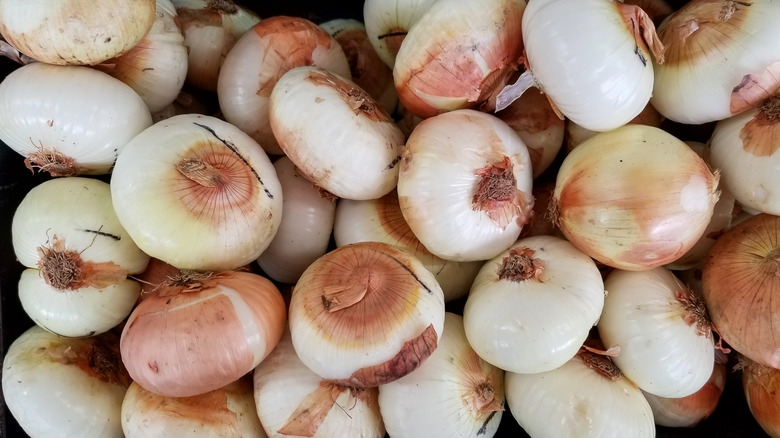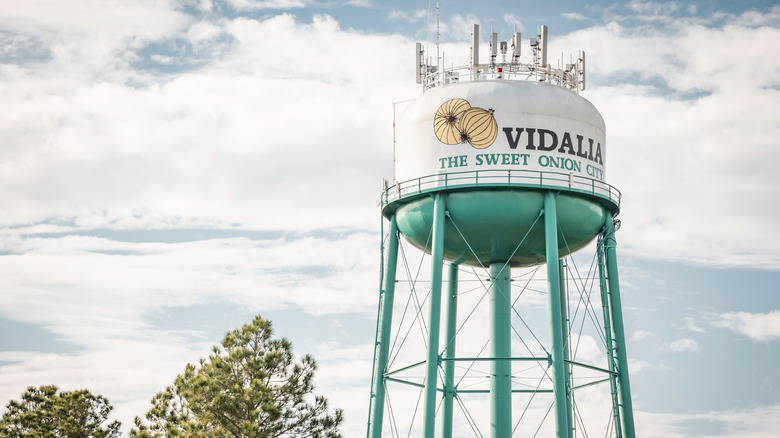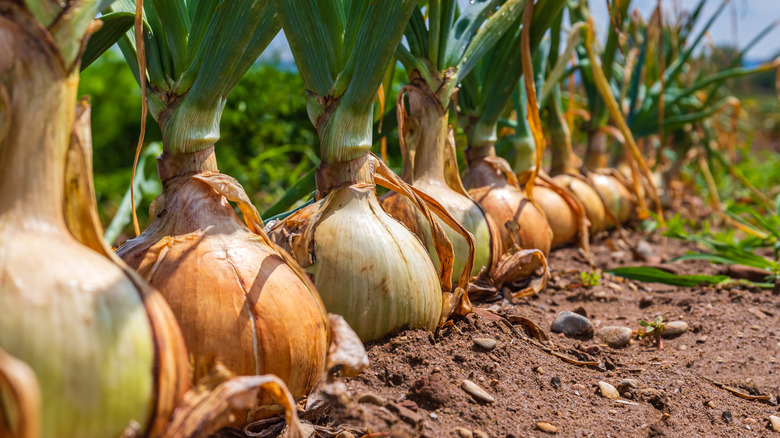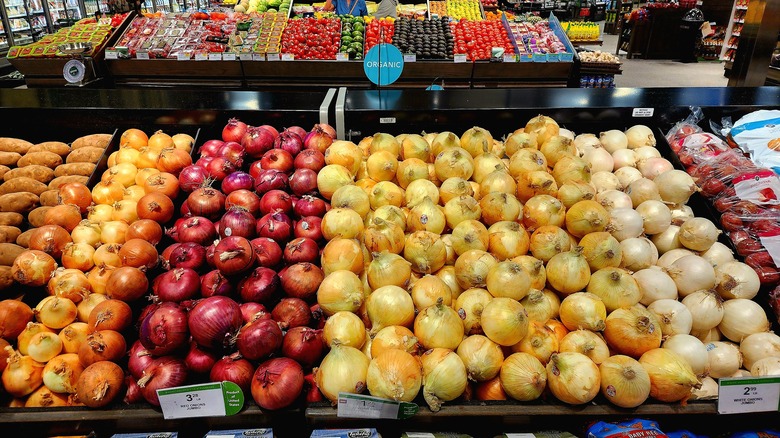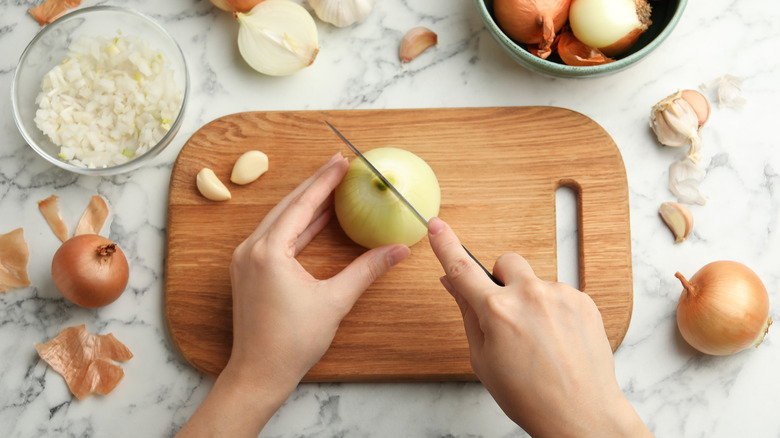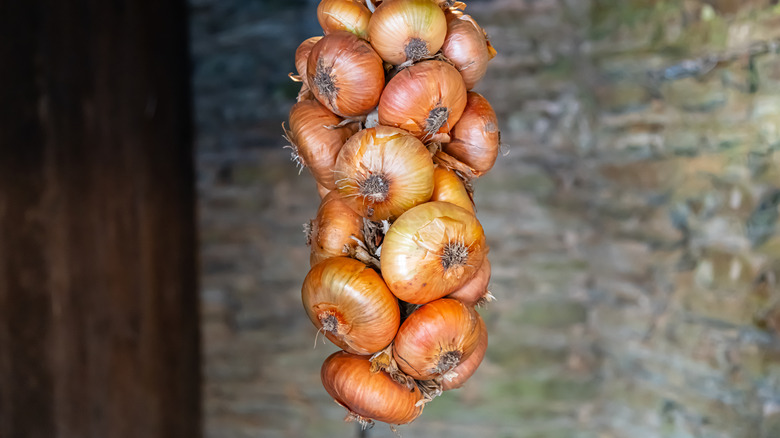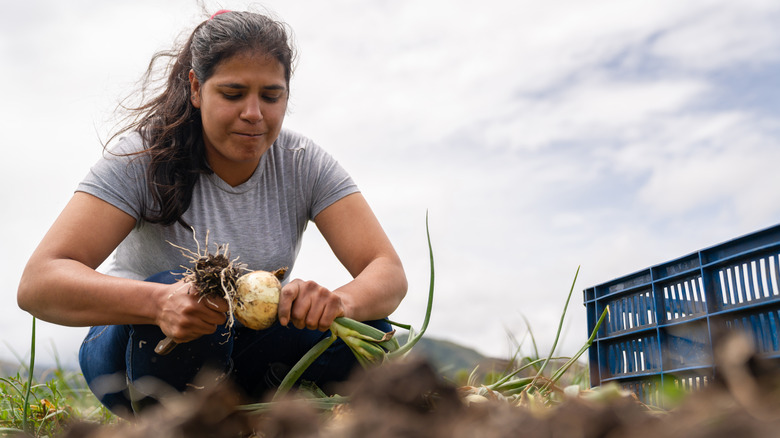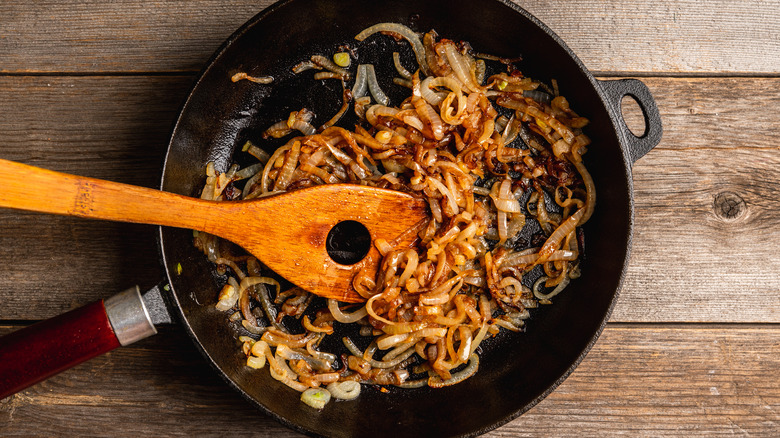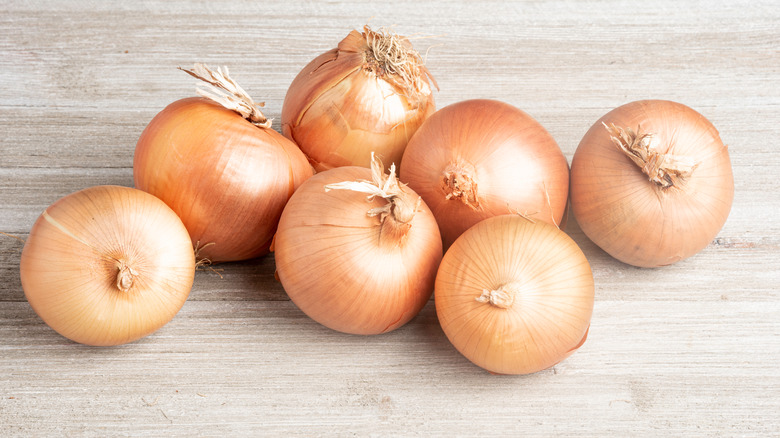What You Didn't Know About Vidalia Onions
Vidalia onions are known for their sweet, mild flavor, making them accessible even to people who don't like the strong taste of traditional onions. Because they don't have such a bite, raw Vidalias are the perfect crunchy addition to salads and sandwiches. And their culinary uses don't end there. A quick search will turn up thousands of recipes that include Vidalia onions, which goes to show just how much they are loved in kitchens all around the world.
A happy accident of the Great Depression, the history of Vidalia onions is pretty fascinating, as are their unique growing conditions and the meticulous care involved in cultivating them. Along with their various role in many popular recipes (including Pimento cheese dip), they boast several health benefits and have surprising pop culture connections that have contributed to their widespread fame. These factors combined make Vidalia onions a beloved ingredient not only in their region of origin, but globally. So without further delay, let's peel back the layers to reveal some fascinating trivia surrounding the Vidalia onion.
Vidalia onions are named after where they're from
In 1931, Moses Coleman, a small-town farmer, was harvesting his onions when he noticed they weren't exactly the crop he was expecting. These onions tasted sweet, and because of that, it was no easy task to sell them at first. But that didn't stop him from trying, and eventually, he was able to sell them for even more than normal onions. Since this was during the Great Depression, making such a pretty penny for his onions was a big stroke of luck when many were struggling financially. Other farmers in the area who weren't turning as much of a profit from their traditional onions followed suit, and soon they were all growing these new, strange, sweet onions.
All of this happened in the region of Vidalia, Georgia, where in 1940, the town became the home of a vibrant farmer's market which sold the local crops. It didn't take long before people began talking about "those Vidalia onions," and so was born the name of these distinctively sweet onions. In the following decades, the local farmers began distributing Vidalia onions across the nation, and the demand for them has never stopped. By 1990, the state of Georgia named the Vidalia onion as its official state vegetable. It remains Georgia's pride and joy to this day. In Vidalia, you'll even find these beloved onions have their own museum and annual festival, which attracts loads of tourists to this otherwise tranquil town.
Georgia is the only place you can legally grow Vidalia onions
It takes a special kind of vegetable to inspire strict laws, and the Vidalia onion is just that — or at least it is for Georgia farmers. According to the Vidalia Onion Act of 1986, you can only legally grow Vidalias in 20 counties in Georgia, all of which surround the town of Vidalia. The act also trademarked the Vidalia name, so there are no ifs ands or buts about it. And if you try to grow Vidalia onions outside of this specific area, even in other parts of Georgia, you'll be sorry, as the penalty is no joke. You'll be looking at a hefty fine as high as $5,000, jail time, or both. Luckily, this only applies to commercial farming. Anyone who wants to grow Vidalia onions for personal use will not be in danger of legal trouble.
The laws about the commercial farming of Vidalia onions don't stop there. And for such a locally beloved crop, why would they? It's also illegal to start selling Vidalia onions before a specific date each year, another provision in the 1986 Vidalia Onion Act. That date is determined annually by the Georgia Agriculture Commissioner and based on the soil and weather conditions throughout that year's growing season.
Vidalia onions grow over winter and are harvested in spring
Unlike most crops, including many other onions, Vidalia onions are planted in the fall, grow over the winter, and are harvested in the spring. As a result, the natural Vidalia season, when consumers can find them in grocery stores and farmers' markets, is from spring to fall. More recent advances in technology, specifically the controlled atmosphere (CA) storage technique, has made it so mass quantities of Vidalia onions can be stored for up to six months, which has increased their availability on the market through the winter.
Of course, the fact that we can only get Vidalia onions during certain parts of the year makes them all the more anticipated and loved. It makes sense that the Vidalia Onion Fest, held in Vidalia, Georgia, attracts tens of thousands of visitors from around the U.S. every year. Consumers who eagerly await their spring arrival can live out their excitement at the festival, celebrating this delicious bulb with Vidalia-inspired camaraderie, music, contests, and games.
Vidalia onions' sweet flavor comes from unique growing conditions
Vidalia onions owe their irresistible sweetness to a perfect harmony of climate, soil, and water in the southern region of Georgia where they grow. This area enjoys mild and wet winters, which is ideal as this is Vidalia onion growing season. During these months, the days are shorter, with only 11-12 hours of sunlight. Between all of that and the low sulfur content in the soil, Vidalia onions develop their uniquely mild and sweet flavor profile.
Most typical onion varieties are grown in Washington, California, and Oregon, where the soil has a lot more sulfur. It is partially due to that sulfur that many onions have such a powerful flavor and smell. On top of that, all the winter rain in southern Georgia is a key player in the Vidalia flavor, as their high water content also contributes to how sweet and mellow they are. Other types of onions have a higher acid content, giving them their characteristic sharpness and bite.
Cutting Vidalia onions won't make you cry
Typical onions have a pungent flavor and scent because they absorb a lot of the sulfur in the soil where they're grown. Enzymes released when cutting into an onion break down, and sulfenic acids are formed. When they are released into the air, they transform into a gas thats sensitive to the eye, which is why many people cry when cutting onions. However, the low sulfur content of the Georgia soil where Vidalia onions grow leads to them having fewer sulfur compounds, which means people don't have to worry about crying when they cut them. This ultimately translates to a more pleasant cooking experience.
In general, other varieties of sweet onions with low sulfur, like Walla Walla and Maui onions, also won't make you cry. And get this: because crying while cutting onions is so annoying, scientists have even developed a new variety of tearless onions through cross-breeding. They go by the name, Sunions. They work by shutting down the gene responsible for producing the enzyme that leads to tears. Still, if you want an un-genetically engineered onion with a naturally mild taste and tear-free experience, Vidalia onions remain an excellent choice.
Vidalia onions have a shorter shelf-life than other onions
While some onions can last up to six months when stored correctly, Vidalia onions typically only last up to two months. This is because their water content is higher than other onions — a quality that is partially responsible for their sweetness as well. However, the extra water Vidalia onions carry also means they bruise more easily, reducing their average shelf-life. You can tell an onion has gone bad if it has visible mold or black fungus spots.
Thankfully, you might be able to extend the shelf-life of fresh Vidalia onions if you're willing to put in a bit of effort. Place your onions in the refrigerator's veggie bin, wrapping each onion separately in paper towel to absorb the moisture. Another way is to store them in sheer pantyhose. To do this, place a single Vidalia onion in the pantyhose, tie a knot, add another onion, tie a knot, and repeat until all your Vidalias are snug inside. Then, hang the pantyhose somewhere cool, dry, and with good ventilation. This might seem like overkill to some, but because Vidalia onions are only available part of the year, it's worth it to keep enjoying their unique sweetness as long as possible.
All Vidalia onions are hand-planted and hand-harvested
Vidalia onions are hand-planted and hand-harvested every year. This intricate process is made necessary by the use of young onion plants, or transplants, which are initially cultivated in tightly packed groups before being moved to more spacious planting areas. Vidalia bulbs are also delicate, which demands careful manual handling during both planting and harvesting. This might not sound all that impressive at first, but consider this: farmers grow around 11,000-12,000 acres of Vidalia onions annually. With approximately 90,000 plants per acre, that's about a billion Vidalia onions that are meticulously hand-planted and hand-harvested each year. Wow.
Workers have to be on their hands and knees during both planting and harvesting, making the process not only physically demanding, but also highly meticulous. Each onion is carefully inspected and handled to ensure that only the best quality onions are selected during harvest. Talk about a high-maintenance vegetable. Thankfully, this labor-intensive process benefits the region's economy. It provides lots of seasonal agricultural jobs and outputs a crop that is highly sought after all summer long.
Vidalia onions can be used instead of sugar to add sweetness to a dish
When looking for natural ways to make a dish sweeter, many people turn to fruits. However, the natural sweetness of Vidalia onions makes them a perfect alternative to sugar in many recipes. On top of that, they can add some nutritional value to any dish, as they are low in calories and rich in vitamins. A 100 gram portion contains approximately 40 calories and 24.3 mg of vitamin C.
On top of that, the Vidalia onion's mild flavor makes it an ideal addition to many foods, such as a tomato-based pasta sauce. A lot of recipes call for white sugar to sweeten up the sauce, but if you use Vidalia onions, the sugar won't be necessary. When they're cooked, their natural sweetness really shines. This makes them one of the best onions to use in cooking. Another smart use of Vidalia onions is in homemade salad dressings. Instead of relying on sugar or honey for sweetness, you can blend finely diced, raw Vidalia onions into a dressing to provide a naturally sweet flavor, balancing the acidity of vinegar or citrus juices perfectly. They can also be used as a base in a caramelized onion recipe to use on top of burgers and sandwiches.
Eat Vidalia onions over other onions if you have a sensitive stomach
Although they're unlikely to cause as much pain as a spicy pepper, for some people, eating onions can cause unpleasant stomach issues like bloating. Vidalia onions are not only milder in taste but easier to digest compared to other types of onions. Their lower quantity of pyruvic acid means they are less likely to trigger uncomfortable symptoms like heartburn, indigestion, and gas, making them a great choice for those with sensitive stomachs. On top of that, Vidalia onions have natural sugars that can provide sweetness to a dish, reducing the need for added sugars. This indirectly protects the stomach from irritation that added sugars can sometimes cause.
The nutritional value of Vidalia onions also contributes to their ease on the stomach. For one, they're a good source of dietary fiber, which promotes digestive health by supporting regular bowel movements and lowering the risk of constipation. Plus, Vidalia onions are rich in quercetin, an antioxidant renowned for its anti-inflammatory properties. Quercetin may benefit gastrointestinal health by helping to soothe stomach irritation and alleviate symptoms of digestive discomfort.
Shrek made Vidalia onions more popular
Remember in the first "Shrek" movie, when Shrek said, "Onions have layers, ogres have layers. Ogres are like onions. End of story"? Well, the Vidalia Onion Committee (yes, that committee exists), did not let this passive onion mention fall by the wayside. They reached out to Dreamworks Animation, owners of the Shrek franchise, and struck a deal to feature Shrek in their marketing of Vidalia onions. The result was huge, with around eight million extra pounds of Vidalia onions flying off the shelves for the early 2010 season. Parents even claimed their children started eating them, and onions are usually a pretty hard sell to kids.
The campaign cleverly aligned itself with the May 2010 release of "Shrek Forever After" and Vidalia harvest season. With the catchy tagline "Shrek Forever After, Vidalias Forever Sweet," the partnership capitalized on the movie's hype to elevate Vidalia onions from a standard ingredient to a cultural sensation. Now, these sweet onions are forever linked to everyone's favorite green ogre.
Vidalia onions are so popular that imposters are brought in during their off-season
Because of their growing season and short shelf life, Vidalia onions are only available from spring to fall. During that time, the Vidalia Onion Committee says the crop adds $120 million of income to the state of Georgia every year. Vidalias are sold in every US state and Canada as well. But some consumers aren't satisfied with only eating their delicious Vidalias between April and September. They want their sweet onions year-round.
And so, during the winter months, when the demand for sweet onions remains high in the U.S., imports from South America come to the rescue. This is possible because of the continent's opposite growing season to the northern hemisphere. The imported, imposter Vidalias are comparable enough in taste to the original, thanks to the fact that certain areas of Peru have similar weather and soil to Georgia. That being said, true Vidalia connoisseurs can likely tell the difference and settle for the South American varieties only because they have no choice.
